

| Company Category : Standard |
| Company name : MSC Cruises |
| Ship name : MSC Splendida |
| Journey Start Date : Sun 13 Mar 2022 |
| Journey End Date : Sat 02 Apr 2022 |
| Port start : Santos, Sao Paulo / Brazil |
| Port end : Genoa / Italy |
| Count Nights : 20 nights |
| Day | Port | Date | Arrival | Departure |
|---|---|---|---|---|
| 1 | Santos, Sao Paulo / Brazil | Sun 13 Mar | 18:00 | |
| 2 | Rio de Janeiro / Brazil | Mon 14 Mar | 08:00 | 18:00 |
| 3 | Day at sea / Sea | Tue 15 Mar | ||
| 4 | El Salvador / Brazil | Wed 16 Mar | 08:00 | 16:00 |
| 5 | Day at sea / Sea | Thu 17 Mar | ||
| 6 | Fortaleza / Brazil | Fri 18 Mar | 08:00 | 14:00 |
| 7 | Day at sea / Sea | Sat 19 Mar | ||
| 8 | Day at sea / Sea | Sun 20 Mar | ||
| 9 | Day at sea / Sea | Mon 21 Mar | ||
| 10 | Day at sea / Sea | Tue 22 Mar | ||
| 11 | Day at sea / Sea | Wed 23 Mar | ||
| 12 | Santa Cruz, about. Tenerife (Canary Islands) / Spain | Thu 24 Mar | 08:00 | 17:00 |
| 13 | Madeira / Portugal | Fri 25 Mar | 09:00 | 18:00 |
| 14 | Day at sea / Sea | Sat 26 Mar | ||
| 15 | Casablanca / Morocco | Sun 27 Mar | 07:00 | 20:00 |
| 16 | Cadiz / Spain | Mon 28 Mar | 10:00 | 18:00 |
| 17 | Malaga / Spain | Tue 29 Mar | 07:00 | 16:00 |
| 18 | Valencia / Spain | Wed 30 Mar | 13:00 | 19:00 |
| 19 | Palma de Mallorca / Spain | Thu 31 Mar | 08:00 | 17:00 |
| 20 | Ayachcho / France | Fri 01 Apr | 13:00 | 19:00 |
| 21 | Genoa / Italy | Sat 02 Apr | 08:00 |
| Build Year : 2009 |
| Width : 38.00 |
| Length : 333.00 |
| Speed : 23.30 |
| Capacity : 3959 |
| Deck Quantity : 18 |
| Cabin Quantity : 1637 |
| Balancer : Yes |
• port taxes
• in the buffet restaurant at the drinks station: cold, hot water, tea 20 hours a day, coffee only during breakfast
• meals in the buffet restaurant: early breakfast, breakfast, snacks in the pizzeria and grill, lunch, dinner, snacks for night owls, drinks from the bar are paid extra
• meals in the a la carte restaurant: breakfast, lunch, dinner without drinks (extra charge)
• entertainment activities on board (evening performances in the theater, live music in bars and lounges, animation shows, disco)
• access to all public areas of the liner, including the library, swimming pools, jacuzzi by the pools, children's water park, gym
• sports games: table tennis, minigolf, shuffleboard
• services of educators and animators for children of five age groups in mini-clubs - from 6 months to 17 years
• transportation of luggage in the ports of the beginning and end of the cruise
• use of boats for embarkation and disembarkation in ports where the liner does not moor to the pier
• only for MSC Yacht Club cabins: ALL INCLUSIVE drinks (value up to 13 €) in the bars and restaurants of the liner and in the minibar in the suite, Premium internet package


Rio de Janeiro is the second-most populous municipality in Brazil and the sixth-most populous in the Americas. The metropolis is anchor to the Rio de Janeiro metropolitan area, the second-most populous metropolitan area in Brazil and sixth-most populous in the Americas. Rio de Janeiro is the capital of the state of Rio de Janeiro, Brazil's third-most populous state. Part of the city has been designated as a World Heritage Site, named "Rio de Janeiro: CariocaLandscapes between the Mountain and the Sea", by UNESCO on 1 July 2012 as a Cultural Landscape.
Founded in 1565 by the Portuguese, the city was initially the seat of the Captaincy of Rio de Janeiro, a domain of the Portuguese Empire. Later, in 1763, it became the capital of the State of Brazil, a state of the Portuguese Empire. In 1808, when the Portuguese Royal Court transferred itself from Portugal to Brazil, Rio de Janeiro became the chosen seat of the court of Queen Maria I of Portugal, who subsequently, in 1815, under the leadership of her son, the Prince Regent, and future King João VI of Portugal, raised Brazil to the dignity of a kingdom, within the United Kingdom of Portugal, Brazil, and Algarves. Rio stayed the capital of the pluricontinental Lusitanian monarchy until 1822, when the War of Brazilian Independence began. This is one of the few instances in history that the capital of a colonising country officially shifted to a city in one of its colonies. Rio de Janeiro subsequently served as the capital of the independent monarchy, the Empire of Brazil, until 1889, and then the capital of a republican Brazil until 1960 when the capital was transferred to Brasília.


a port on the Atlantic coast of eastern Brazil, capital of the state of Bahia; population 2,892,625 (2007).


a port in northeastern Brazil, on the Atlantic coast; population 2,431,415 (2007).







Madeira, officially the Autonomous Region of Madeira, is one of the two autonomous regions of Portugal (along with the Azores). It is an archipelago situated in the north Atlantic Ocean, southwest of Portugal. Its total population was estimated in 2011 at 267,785. The capital of Madeira is Funchal, which is located on the main island's south coast.
The archipelago is just under 400 kilometres (250 mi) north of Tenerife, Canary Islands. Bermuda and Madeira, a few time zones apart, are the only land in the Atlantic on the 32nd parallel north. It includes the islands of Madeira, Porto Santo, and the Desertas, administered together with the separate archipelago of the Savage Islands. The region has political and administrative autonomy through the Administrative Political Statue of the Autonomous Region of Madeiraprovided for in the Portuguese Constitution. The autonomous region is an integral part of the European Union as an outermost region.


Casablanca located in the central-western part of Morocco and bordering the Atlantic Ocean, is the largest city in Morocco. It is also the largest city in the Maghreb region, as well as one of the largest and most important cities in Africa, both economically and demographically.
Casablanca is Morocco's chief port and one of the largest financial centers on the continent. According to the 2014 population estimate, the city has a population of about 3.35 million in the urban area and over 6.8 million in the Casablanca-Settat region. Casablanca is considered the economic and business center of Morocco, although the national political capital is Rabat.
The leading Moroccan companies and international many corporations doing business in the country have their headquarters and main industrial facilities in Casablanca. Recent industrial statistics show Casablanca retains its historical position as the main industrial zone of the country. The Port of Casablanca is one of the largest artificial ports in the world, and the second largest port of North Africa, after Tanger-Med 40 km (25 mi) east of Tangier. Casablanca also hosts the primary naval base for the Royal Moroccan Navy.


Málaga is a municipality, capital of the Province of Málaga, in the Autonomous Community of Andalusia, Spain. With a population of 569,130 in 2015, it is the second-most populous city of Andalusia and the sixth-largest in Spain. The southernmost large city in Europe, it lies on the Costa del Sol (Coast of the Sun) of the Mediterranean, about 100 kilometres (62.14 miles) east of the Strait of Gibraltar and about 130 km (80.78 mi) north of Africa.
Málaga's history spans about 2,800 years, making it one of the oldest cities in the world. According to most scholars, it was founded about 770 BC by the Phoenicians as Malaka From the 6th century BC the city was under the hegemony of Ancient Carthage, and from 218 BC, it was ruled by the Roman Republic and then empire as Malaca (Latin). After the fall of the empire and the end of Visigothic rule, it was under Islamic rule as Mālaqah for 800 years, but in 1487, the Crown of Castille gained control after the Reconquista. The archaeological remains and monuments from the Phoenician, Roman, Arabic and Christian eras make the historic center of the city an "open museum", displaying its history of nearly 3,000 years.
This important cultural infrastructure and the artistic heritage have culminated in the nomination of Málaga as a candidate for the 2016 European Capital of Culture.
The painter and sculptor Pablo Picasso, Hebrew poet and Jewish philosopher Solomon Ibn Gabirol and the actor Antonio Banderas were born in Málaga. The magnum opus of Cuban composer Ernesto Lecuona, "Malagueña", is named after the music of this region of Spain.
The most important business sectors in Málaga are tourism, construction and technology services, but other sectors such as transportation and logistics are beginning to expand. The Andalusia Technology Park (PTA), located in Málaga, has enjoyed significant growth since its inauguration in 1992. Málaga is the main economic and financial centre of southern Spain, home of the region's largest bank, Unicaja, and the fourth-ranking city in economic activity in Spain behind Madrid, Barcelona and Valencia.


Mallorca is the largest island in the Balearic Islands, which are part of Spain and located in the Mediterranean. The native language, as on the rest of the Balearic Islands, is Catalan, which is co-official with Spanish.
The capital of the island, Palma, is also the capital of the autonomous community of the Balearic Islands. The Balearic Islands have been an autonomous region of Spain since 1983. There are two small islands off the coast of Mallorca: Cabrera (southeast of Palma) and Dragonera (west of Palma). The anthem of Mallorca is "La Balanguera".
Like the other Balearic Islands of Menorca, Ibiza and Formentera, the island is an extremely popular holiday destination, particularly for tourists from Germany and the United Kingdom. The international airport, Palma de Mallorca Airport, is one of the busiest in Spain; it was used by 28.0 million passengers in 2017, increasing every year since 2012.
The name derives from Classical Latin insula maior, "larger island". Later, in Medieval Latin, this became Maiorica, "the larger one", in comparison to Menorca, "the smaller one".

Ajaccio is a French commune, prefecture of the department of Corse-du-Sud, and head office of the Collectivité territoriale de Corse (capital city of Corsica). It is also the largest settlement on the island. Ajaccio is located on the west coast of the island of Corsica, 210 nautical miles (390 km) southeast of Marseille.
The original city went into decline in the Middle Ages, but began to prosper again after the Genoese built a citadel in 1492 to the south of the earlier settlement. After the Corsican Republic was declared in 1755 the Genoese continued to hold several citadels, including Ajaccio, until the French took control of the island.
The inhabitants of the commune are known as Ajacciens or Ajacciennes. The most famous of these is Napoleon Bonaparte who was born in Ajaccio in 1769, and whose ancestral home, the Maison Bonaparte, is now a museum. Other dedications to him in the city include Ajaccio Napoleon Bonaparte Airport.

Genoa is the capital of the Italian region of Liguria and the sixth-largest city in Italy. In 2015, 594,733 people lived within the city's administrative limits. As of the 2011 Italian census, the Province of Genoa, which in 2015 became the Metropolitan City of Genoa, counted 855,834 resident persons. Over 1.5 million people live in the wider metropolitan area stretching along the Italian Riviera.
Located on the Gulf of Genoa in the Ligurian Sea, Genoa has historically been one of the most important ports on the Mediterranean: it is currently the busiest in Italy and in the Mediterranean Sea and twelfth-busiest in the European Union. Genoa has been nicknamed la Superba ("the proud one") due to its glorious past and impressive landmarks. Part of the old town of Genoa was inscribed on the World Heritage List (UNESCO) in 2006 as Genoa: Le Strade Nuove and the system of the Palazzi dei Rolli. The city's rich cultural history in art, music and cuisine allowed it to become the 2004 European Capital of Culture. It is the birthplace of Christopher Columbus, Andrea Doria, Niccolò Paganini, Giuseppe Mazzini, Renzo Piano and Grimaldo Canella, founder of the House of Grimaldi, among others.
Genoa, which forms the southern corner of the Milan-Turin-Genoa industrial triangle of Northwest Italy, is one of the country's major economic centers. The city has hosted massive shipyards and steelworks since the 19th century, and its solid financial sector dates back to the Middle Ages. The Bank of Saint George, founded in 1407, is among the oldest in the world and has played an important role in the city's prosperity since the middle of the 15th century. Today a number of leading Italian companies are based in the city, including Fincantieri, Selex ES, Ansaldo Energia, Ansaldo STS, Edoardo Raffinerie Garrone, Piaggio Aerospace, Mediterranean Shipping Company and Costa Cruises.